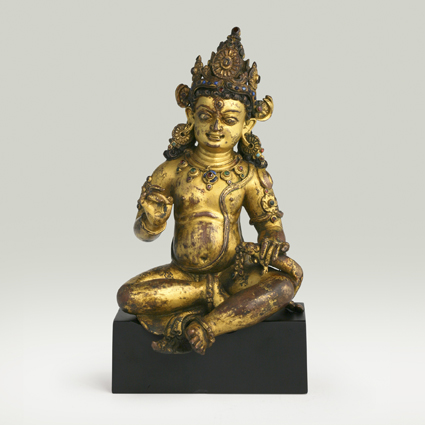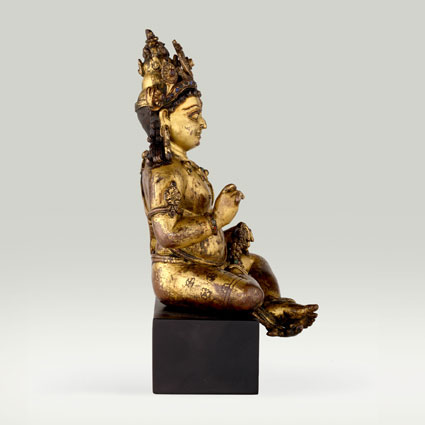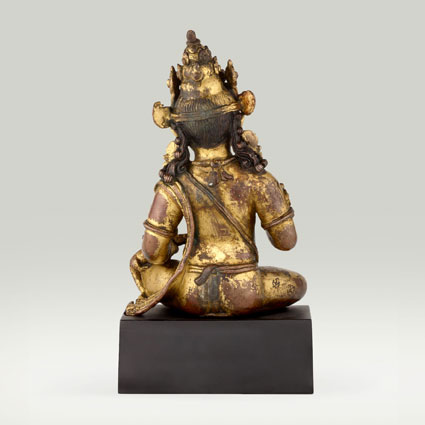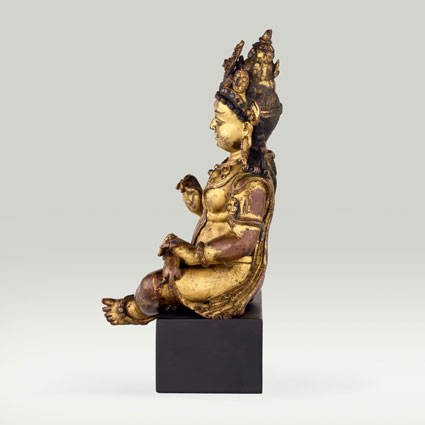ABS 137
Code: ABS 137
Country: Nepal
Style: Early Malla Period
Date: 1200 - 1300
Dimensions in cm WxHxD: 12.4 x 20 x 6.8
Materials: Gilt copper. Inset with rubies, turquoise, etc.
Kubera (sanskrit) or Jambhala (Tibetan), God of Wealth
Corpulent and clad only in a loincloth, but adorned with jewels, the god of wealth caresses the gem-spouting mongoose (nakula), with his left hand. Typical of wrathful protecting deities, his smile with glinting canines and dilated eyes gives him a menacing appearance. His jewellery is richly set with precious stones such as ruby, lapis lazuli and turquoise. The technical perfection and the magnificent mercury gilding of this unusually large representation of Jambhala are typical of Nepalese artistic production. But the fact that the gilding is intact suggests that this statue was in the custody of a Tibetan monastery and had very seldom been touched. In the Kathmandu valley, daily ritual washings would have worn away the gilding.
The iconography does not reveal whether it represents Kubera, the god of wealth in Hinduism, or Jambhala, his Buddhist version. Both Kubera (in Hindu-religions) and Jambhala are linked to Vaishravana, even though they each can appear under different aspects. Under the name of Vaishravana, the deity is one of the guardians of the cardinal directions, and reigns over the north. Under the name of Kubera, he is the god of wealth. He wears the five-fold bodhisattva crown and carries the banner of victory with the wish fulfilling jewel in his right hand. Sometimes he rides on a snow lion. In Tibetan Buddhism he appears under the name of Jambhala. He is a protector in all the lineages, and is considered to be an emanation of Avalokiteshvara (tib.: Chenrezig), representing compassion and generosity. Jambhala appears under five different forms and colours, and each is linked to one of the five victorious Buddhas, showing different attitudes and attributes. The yellow Jambhala is the most popular. The jewel-spitting mongoose is always present, and clearly identifies these deities of wealth.
Wealth is considered to provide freedom, so that one may focus on the path of spirituality rather than on materiality and worries about the temporality of wealth.
The puja dedicated to the five Jambhalas is believed to summon positive wealth energies upon the participants. Even though wealth is supposed to result from one’s past actions, it is nevertheless believed that this puja can play a significant role in changing the course of one’s financial situation.
Corpulent and clad only in a loincloth, but adorned with jewels, the god of wealth caresses the gem-spouting mongoose (nakula), with his left hand. Typical of wrathful protecting deities, his smile with glinting canines and dilated eyes gives him a menacing appearance. His jewellery is richly set with precious stones such as ruby, lapis lazuli and turquoise. The technical perfection and the magnificent mercury gilding of this unusually large representation of Jambhala are typical of Nepalese artistic production. But the fact that the gilding is intact suggests that this statue was in the custody of a Tibetan monastery and had very seldom been touched. In the Kathmandu valley, daily ritual washings would have worn away the gilding.
The iconography does not reveal whether it represents Kubera, the god of wealth in Hinduism, or Jambhala, his Buddhist version. Both Kubera (in Hindu-religions) and Jambhala are linked to Vaishravana, even though they each can appear under different aspects. Under the name of Vaishravana, the deity is one of the guardians of the cardinal directions, and reigns over the north. Under the name of Kubera, he is the god of wealth. He wears the five-fold bodhisattva crown and carries the banner of victory with the wish fulfilling jewel in his right hand. Sometimes he rides on a snow lion. In Tibetan Buddhism he appears under the name of Jambhala. He is a protector in all the lineages, and is considered to be an emanation of Avalokiteshvara (tib.: Chenrezig), representing compassion and generosity. Jambhala appears under five different forms and colours, and each is linked to one of the five victorious Buddhas, showing different attitudes and attributes. The yellow Jambhala is the most popular. The jewel-spitting mongoose is always present, and clearly identifies these deities of wealth.
Wealth is considered to provide freedom, so that one may focus on the path of spirituality rather than on materiality and worries about the temporality of wealth.
The puja dedicated to the five Jambhalas is believed to summon positive wealth energies upon the participants. Even though wealth is supposed to result from one’s past actions, it is nevertheless believed that this puja can play a significant role in changing the course of one’s financial situation.






